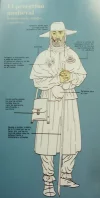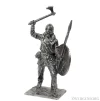scruffy1
Veteran Member
- Time of past OR future Camino
- Holy Year from Pamplona 2010, SJPP 2011, Lisbon 2012, Le Puy 2013, Vezelay (partial watch this space!) 2014; 2015 Toulouse-Puenta la Reina (Arles)
We see here two very contrasting medieval figures, one the classical representation of a Pilgrim the other a somewhat fanciful depiction of an evil marauding Norseman – not much in common.


Now they both do share one small particularity, at their waist they both carry a small bag usually intended for foodstuffs and perhaps personal items, usually termed scrip-later a word for small change. Please read on and Wait for it. As we read through the Bible such an item appears and is also termed a scrip – see David and Goliath for but one example where in Hebrew it is called a shepherds' pouch. Soooo? Where in the name of all that is good came the word scrip? Oh dear! Shocking! Working back, the word appears in Old French as escrepe (“purse, alms-bag”) the 'e' falling away as in the word esquire – an aphetism, springing from a variant of escharpe in French, and this from Old Norse skreppa (!) related with and similar to (oh my goodness!) the Danish skreppe (“scrip”).
Ivar strikes again!!!


Now they both do share one small particularity, at their waist they both carry a small bag usually intended for foodstuffs and perhaps personal items, usually termed scrip-later a word for small change. Please read on and Wait for it. As we read through the Bible such an item appears and is also termed a scrip – see David and Goliath for but one example where in Hebrew it is called a shepherds' pouch. Soooo? Where in the name of all that is good came the word scrip? Oh dear! Shocking! Working back, the word appears in Old French as escrepe (“purse, alms-bag”) the 'e' falling away as in the word esquire – an aphetism, springing from a variant of escharpe in French, and this from Old Norse skreppa (!) related with and similar to (oh my goodness!) the Danish skreppe (“scrip”).
Ivar strikes again!!!
Last edited:











